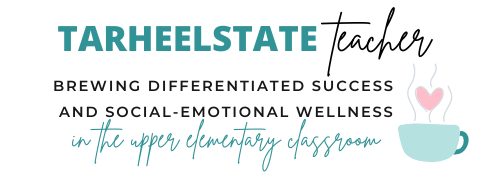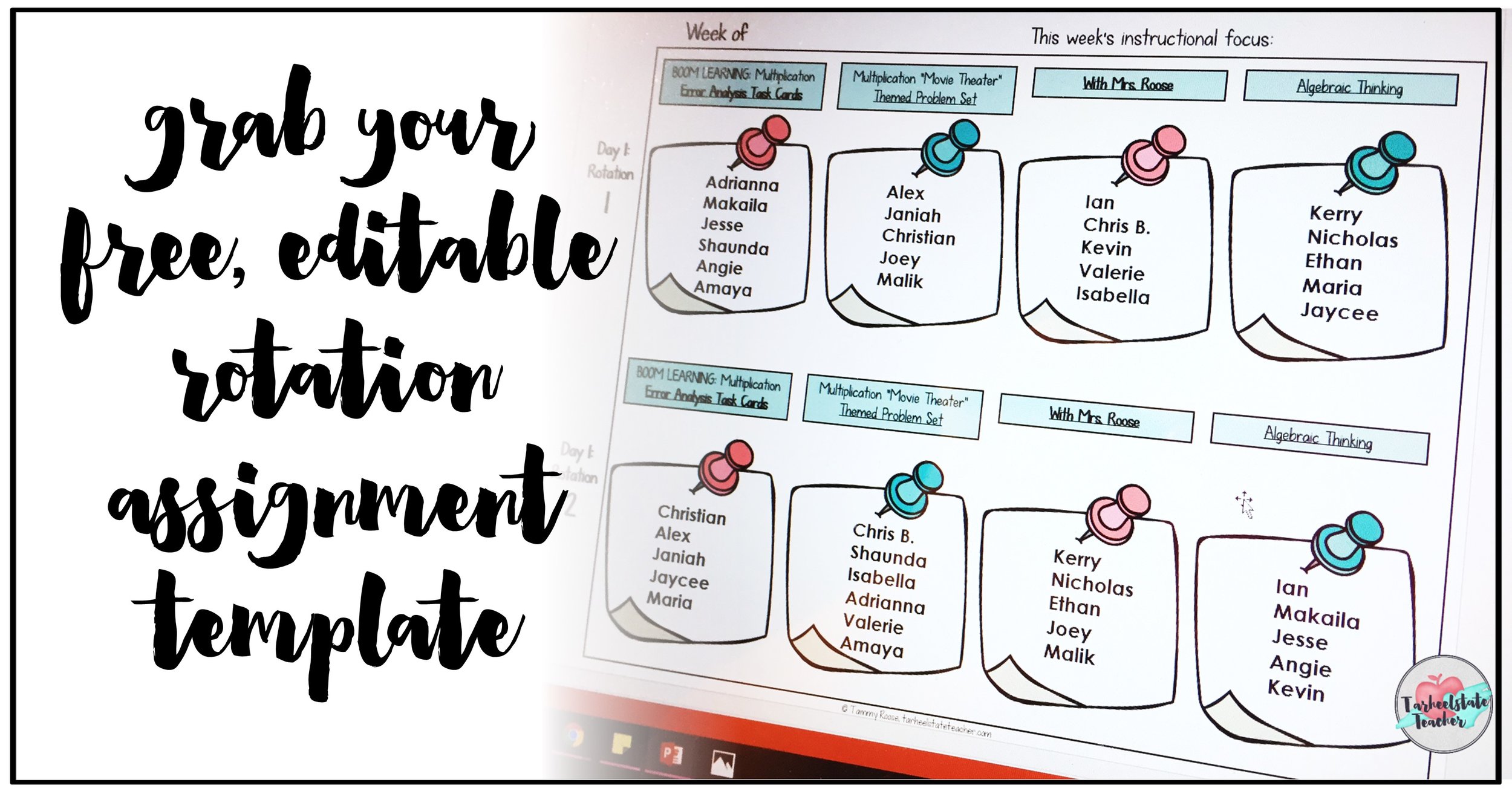Free Math Stations Rotation Template for Upper Elementary
My math stations rotation template is perhaps the most essential tool I use to plan for and manage my math rotations. I use it to map out the variety of activities my students will complete, create small groups for interventions or enrichment, and organize student groups that will work well together. Today, I'm also sharing how my math stations are differentiated, even if the differentiation is not readily apparent on the assignment template. Be sure to grab the free rotation template to use in your classroom!
During math stations, my students don't necessarily work together on assignments, but they do often share the same space (at the carpet, at a table) and materials (task cards, manipulatives, etc). As you are aware, grouping students can be a huge headache and lack of good behavior or a sense of urgency is often a reason teachers decide that small groups and math stations are not worth the fuss.
Well, to organize my math stations, I type up my math station rotations and assignments into a Powerpoint. I keep behavior and ability in mind as I'm assigning students to their stations. I think about whether or not I want the students grouped heterogeneously (everyone will eventually complete this task and I can focus more on separating behavior issues) or homogeneously (the task is differentiated).
The beauty of planning with my PowerPoint template is that I can duplicate the slides and change the assignments for the next week's round of stations. If I need to tweak any of my student groups (because of behavior or performance), I can do this easily, because I already have a template to work from.
I don't know if it's just me, but I put a lot of thought into creating small groups. I think about so many aspects and it takes time. But, after I do it again and again and revise groups based on behavior and student needs, it gets easier and easier.
How I Assign students to Math Stations:

1) Using a differentiated, leveled pre-assessment for a specific standard, a classroom assignment, and/or my daily observations, I sort my students on a continuum of understanding. My continuum levels typically look like this:

BUILDING BLOCKS: Students need to focus on below-grade level standards that relate to the grade-level standards we are working on
GOALS: Students are ready for grade-level work
More Challenging Grade Level Goals: Students are ready for more challenging grade-level work
STRETCHING BEYOND: Students are ready for beyond grade-level work
2) Next, I create my "meet with the teacher" small groups (if I feel that this is the best use of myself based on student data and student needs) and I plug my small groups into the schedule first since these are less flexible. I've shared that I don't always have a "meet with the teacher" rotation because I find that I'm often more useful when I'm "on my feet" and able to work with students as they complete their rotation assignments.

If I do not put "meet with the teacher" into my schedule, the groups I've created based on the continuum of abilities still comes into play when I make my assignments. I can put a little star on my schedule to note specific groups and students that I want to make sure I provide support to.
3) Next, I consider the assignments I want students to complete during these rotations. I really like for students to have independent work, but I want them to benefit from moving around the room during stations, so I try to make sure students only have one “At Your Seat” type of activity each day. (In this example, the Movie Theater problem and Algebraic Thinking stations are “At Your Seat” activities. (it helps to color code "at seat" assignments as I have done in teal).

If you look at the top half of my schedule (Day 1 rotations), students who will meet with me on this day now need an “At Your Seat” activity. These students will usually not do a game or other "hands-on activity" on the same day that they have met with me. So I plug them in to the Movie Theater Problems or Algebraic Thinking (or a set of paper-based task cards) next.
4) Now that I know when students will "meet with the teacher," I can also place them into a game, hands-on, partner activity, Boom Learning or other web-based assignment on the opposite day. (Again, since they won't be meeting with me that day, this gives them more engagement and movement away from their desk.
Then, I continue assigning students until all have been scheduled for each day and each rotation.
Tweaking the system
After the first day of rotations, I review the schedule for the next day, think about student behavior and needs, and make any adjustments. For example, if someone had poor behavior in a task card station, I can ensure that they work on task cards at their desk the following day. Reviewing my Day 2 assignments is also an opportunity for me to decide whether or not a student needs a second day on the topic we are currently working on. Perhaps I pull them into a small group again and they do not complete “Algebraic Thinking” that week. You have permission to make these kinds of decisions!
For the love of differentiation!
In my math stations blog series, I've written a lot about my love of stations.
But I also want to clarify something so that you do not get the wrong impression. While I passionately believe in differentiation, I do not believe that every station or every set of rotations must have differentiated, individualized work for each student.
I do love and believe in stations because they provide me with an awesome structure for differentiation in math, but I also love stations for a lot of other reasons (that you can read about in that post!). With that said, sometimes differentiation is happening in our assignments in "not so obvious" ways.
Here are some ways that student assignments are differentiated in my math stations:
1) Math Task Cards and Boom Learning are differentiated assignments. When necessary, I assign different sets of task cards to different student groups. For example, when working on Subtracting Fractions with regrouping, students may work on subtracting fractions from a whole number (level 1), subtracting fractions from a mixed number with LIKE denominators (level 2), or subtracting mixed numbers with unlike denominators (level 3). I print each level of these task cards on different colors of cardstock so that I can just note which color students should start with on my rotation schedule. (These leveled subtracting fractions task cards are in my TPT store.)
In Boom Learning, I can assign students many sets of task cards and they can complete them as they are ready. Students can also play the same task card sets again and again to demonstrate mastery or gain more practice. Since Boom Cards are self-checking, students get immediate feedback. Everyone can work at their own pace and I can intervene with students who need more support.
2) My Real-World Themed Word Problem sets are differentiated with three levels of challenge (building blocks, goals, and stretching beyond). These can be assigned to students based on their level of mastery. I recommend taking at least one step back from students’ mastery level to give them more practice and help them build confidence before working on the next level, or I just assign all three levels of the problem set because the problem sets are themed and all sets build on one another (my preference).
Because the levels start at below-grade level standards and get increasingly more challenging, students are able to show deficits and higher levels of mastery than if they only completed a grade-level based assignment. If you are not tied down to a small group, you can help students work through the challenges presented by each level.
3) When students “Meet with the Teacher” that instruction can be fully differentiated with different lessons and materials, or I can use the same materials but differentiate by simply “meeting students where they are,” teaching them different or modified procedures, and instructing them from that point. {You know, how we teachers differentiate on the fly?}
Other Parts on the Rotation Assignment Schedule:
The Day’s Date and Instructional Focus
I highly recommend saving your rotation schedules/plans. I like starting a separate file for each new unit of study. I am sure to put the date of the week or station days and the instructional focus.
When I started using a PowerPoint template to plan my math stations, I realized that by saving those plans, I would always have evidence of how I differentiated my math instruction for ALL of my students. If an EC teacher or parent had questions about how I was meeting their child's needs, I could refer to my rotation schedules as my "notes" for how I modified assignments for them. If a parent of a gifted student had questions about how I was challenging their child, I could show them that I have levels of assignments in my rotations and that their student was completing assignments that other students did not.
Tips for Displaying your Rotations for the Day
You could put each rotation on a separate slide and enlarge the text/assignments, but I find that to be unnecessary and more work than I want to do. My Math Stations assignment chart is supposed to be down and dirty, quick and easy.
However, I do like to break up the 2-day plan into two separate slides in my PowerPoint so that Day 1 and Day 2 are on separate slides.

To make it easier for students to focus on and find their station assignment, I recommend using a colored rectangle to hide the rotation that you are not currently working on.
You can have a student helper move the “shade” when the rotation is over. I have placed a shade in the slide templates for you where appropriate. You can just move it to the side when you are making your assignments or delete it if you do not want it.
What about that math stations rotation template freebie?
Want more helpful math stations tips? Check out these posts about Math Stations:
⇒ An Overview of My Upper Elementary Math Stations
⇒ 5 Rules for Math Stations...that you can break!
⇒ Math Station Essentials {Tools for Organization and Management}




